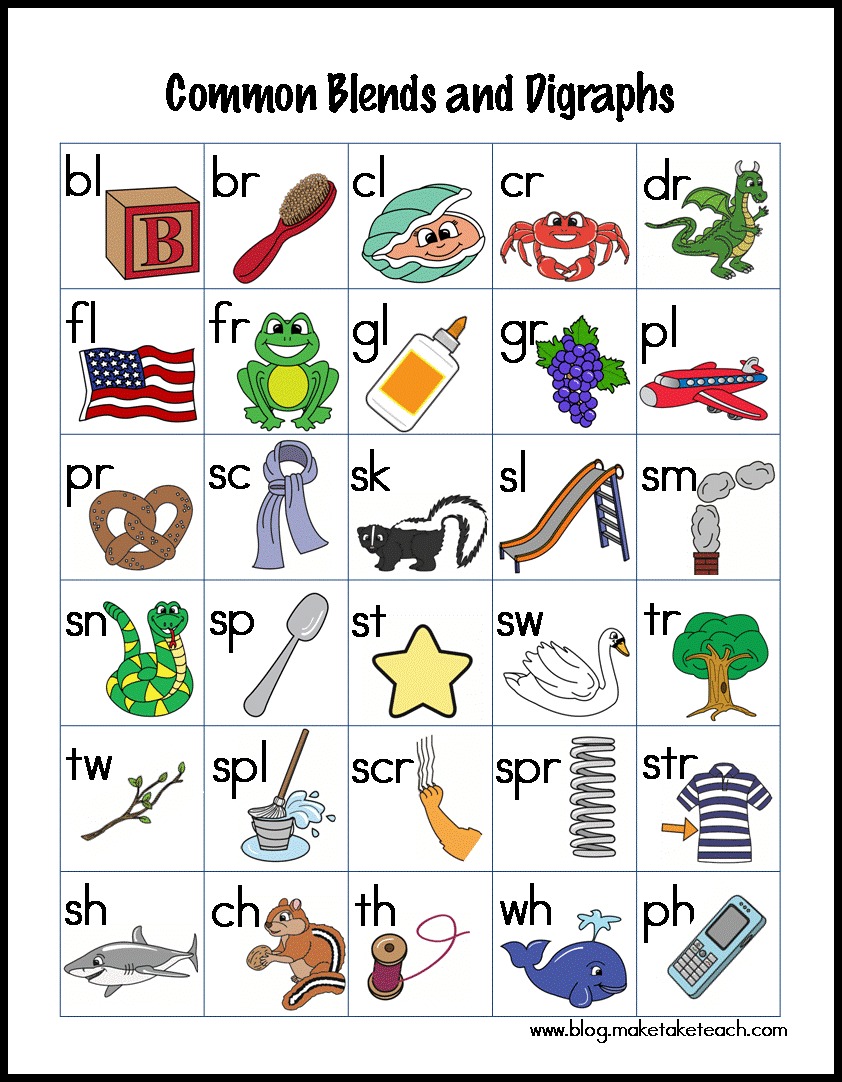Many of my first grade friends are now learning common blends and digraphs. I thought it’d help if I gathered a few of my favorite resources and activities as well as answer common questions for introducing and practicing this skill.
What’s the difference between a blend and a digraph?
Consonant Blends
A consonant blend is when two or more consonants are blended together, but each sound may be heard in the blend. The most common beginning consonant blends include: bl, br, cl, cr, dr, fr, tr, fl, gl, gr, pl, pr, sl, sm, sp and st. Blends can also occur at the end of words as in the word “last”. There are also blends which contain three consonants. Common three consonant blends include: str, spl, and spr. When teaching blends, most teachers introduced them in groups. For example, a teacher may choose to introduce the l-blends first (bl, cl, fl, gl, pl and sl) followed by the r-blends. When introducing the concept of blends and digraphs, cue cards often help. Here’s one I made with many of the consonant blends. You can download this for free.
Click HERE to download this freebie from my TpT store
Consonant Digraphs
In a consonant digraph, two consonants stand together to represent a single sound. The most common consonant digraphs are: sh, ch, th, and wh. There are other consonant digraphs (ph); however, most teachers typically introduce these 4 digraphs first as they are the most common. They are often referred to as the “h brothers”. Teaching digraphs can be lots of fun. However you choose to introduce this concept, be sure to add visuals as they are so helpful especially for our struggling readers. Here’s the cue card specifically for digraphs that I made to introduce the concept. Specific instructions for introducing digraphs during instruction can be found in the Consonant Blends and Digraphs Activity Pack.
Click HERE to download this cue card for free from my TpT store
Sometimes you just need a list of words to support instructional activities. Just click the following link to download a list of common words containing consonant digraphs
To download this handout just click the following link: Common-Consonant-Digraph-Word-List
Which should be taught first?
This is a little tricky. Some reading programs do not even teach blends as they are really two separate sounds. Personally, I believe teaching blends is a good idea as they are letters that frequently occur together so students are learning to recognize patterns in words. Many reading programs introduce blends before the digraphs. I would suggest following the sequence presented in your reading series.
How do we teach blends and digraphs?
For all learners, but especially for struggling readers, systematic and explicit phonics instruction is critical. “Systematic phonics instruction” refers to the sequence of phonics skills introduced. In a phonics program, there must be a logical order of introduction of skills. “Explicit phonics instruction” refers to how the skills are taught. Students need instruction where the teacher is providing precise directions for teaching the skills. Struggling readers require additional guided practice in small groups and instruction must be differentiated to meet individual needs.
Make, Take & Teach Resources for Teaching Blends and Digraphs
Call me crazy, but love digraphs almost as much as I love short vowel sounds. It’s so rewarding to see our young readers begin to move beyond just single letters and sounds and move towards more advanced phonics skills. The Consonant Blends and Digraphs Activity Pack contains 15 hands-on activities that you can use to both teach and practice blends and digraphs. The activities are designed specifically for small group instruction and contains a 26 page teaching manual with step-by-step instructions for each activity.
The Consonant Blends and Digraphs Activity Pack is available through my online TpT store or through the Make, Take & Teach website.
Volume 5 of the Cookie Sheet Challenge was designed specifically for practicing blends and digraphs. The cookie sheet activities are great for use within literacy centers and contain activities which can be differentiated. Students and teachers just love the colorful graphics.
The Cookie Sheet Activities for Blends and Digraphs is also available in my TpT store or through the Make, Take & Teach website.
The Write It Phonics Cards are great for centers. To assemble the cards simply print them on card stock, laminate and bind them together with a loose leaf ring. The cards can be used over and over again.
The Write-It Phonics Cards for Consonant Blends is available in my TpT store or through the Make, Take & Teach website.
The Write-It Phonics Cards for Consonant Digraphs is available in my TpT store or through the Make, Take & Teach website.
If you have any fun ideas for teaching blends and digraphs, please let us know by leaving a comment. To leave a comment on this blog post, just click the title.










Leave a Reply